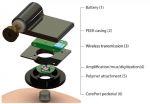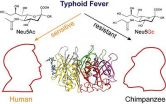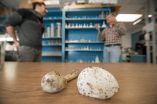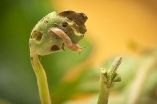(Press-News.org) PROVIDENCE, R.I. [Brown University] -- In a study in the journal Neuron, scientists describe a new high data-rate, low-power wireless brain sensor. The technology is designed to enable neuroscience research that cannot be accomplished with current sensors that tether subjects with cabled connections.
Experiments in the paper confirm that new capability. The results show that the technology transmitted rich, neuroscientifically meaningful signals from animal models as they slept and woke or exercised.
"We view this as a platform device for tapping into the richness of electrical signals from the brain among animal models where their neural circuit activity reflects entirely volitional and naturalistic behavior, not constrained to particular space," said Arto Nurmikko, professor of engineering affiliated with the Brown Institute for Brain Science and the paper's senior and corresponding author. "This enables new types of neuroscience experiments with vast amounts of brain data wirelessly and continuously streamed from brain microcircuits."
The custom-engineered neuroelectronic platform is composed of two elements: a 100-channel transmitter only 5 centimeters in its largest dimension and weighing only 46.1 grams, and a four-antenna receiver that looks like a home Wi-Fi router but employs sophisticated signal processing to maximize the transmitter's signal while the subject is moving around. Via a small port embedded in a subject's skull, the transmitter connects to a tiny implanted electrode array that detects the activity of scores of neurons in the cortex. The wireless transmitter is compatible with multiple types and classes of brain sensors, Nurmikko said, with a view toward future sensor development
"Among the unique features of our technology is that we developed this compact lightweight neurosensor with a custom-designed low-power high-efficiency transmitter," said paper lead author Ming Yin, a research engineer in Nurmikko's lab at Brown at the time of the work. "It dissipates two magnitudes less power than commercial 802.11n transceivers to broadcast a comparable rate of high-speed data - up to 200 megabits per second - within a few meters distance. The low power and small size, along with built-in electrostatic discharge protection features, make our device safer and more practical for mobile subjects."
In the study the team demonstrated that the transmitter can run continuously for more than 48 hours on a single rechargeable AA battery as it relays a high rate of data directly from the brain.
"The brain sensor is opening unprecedented opportunities for the development of neuroprosthetic treatments in natural and unconstrained environments," said study co-author Grégoire Courtine, a professor at EPFL (École polytechnique fédérale de Lausanne), who collaborated with Nurmikko's group on the research.
Behavioral Demonstrations
Courtine and co-lead author David Borton helped to lead experiments testing whether the system could match the performance of the common wired systems. They, with colleagues at Brown and the Bordeaux Institute of Neuroscience, also applied it in two behavioral tasks to ensure that it relayed scientifically interesting neural patterns. The experiments employed a platform developed by the European Project NeuWalk, which is supported by a €9-million investment from European Union.
In one experiment, three rhesus macaques took walks on a treadmill while the researchers used the wireless system to measure neural signals associated with the brain's motion commands. Meanwhile they used other sensors to measure the activity of leg muscles. The data from the brain showed clear patterns of activity related to the movements of the muscles, demonstrating that the sensor allows for studies of how the brain controls the legs.
"In this study, we were able to observe motor cortical dynamics during locomotion, yielding insight into how the brain computes output commands sent to the legs to control walking," said Borton, now assistant professor of engineering at Brown.
In another experiment, the Brown and EPFL researchers used the technology to observe brain signals for hours on end as the animal subjects went through sleep/wake cycles, unencumbered by cables or wires. Again the data showed distinct patterns related to the different stages of consciousness and the transitions between them.
"We hope that the wireless neurosensor will change the canonical paradigm of neuroscience research, enabling scientists to explore the nervous system within its natural context and without the use of tethering cables," Borton said. "Subjects are free to roam, forage, sleep, etc., all while the researchers are observing the brain activity. We are very excited to see how the neuroscience community leverages this platform."
In 2013, Yin, Borton, and Nurmikko unveiled a related, implantable wireless brain sensor with a different design. Whereas the new head-mounted sensor is intended for research use by the wider brain science community, Nurmikko said, the researchers hope that wireless brain sensor technology will be useful in clinical research as well in the coming years.
Blackrock Microsystems LLC of Utah, where Yin is now an engineer, has licensed a portion of the technology described in the new Neuron study from Brown University for commercial development.
INFORMATION:
In addition to Yin, Borton, Nurmikko, and Courtine, the paper's other authors are Jacob Komar, Naubahar Agha, and Yao Lu of Brown;Christopher Bull, professor of engineering, and Lawrence Larson dsean of engineering at Brown; David Rosler of Brown and the Providence Veterans Affairs Medical Center; Jean Laurens of EPFL; Hao Li of Marvell Semiconductor; Yiran Liang and Erwan Bezard of the Bordeaux Institute of Neuroscience; and Qin Li of Motac Neuroscience. Bezard and Li are also affiliated with the China Academy of Medical Sciences.
The U.S. National Institutes of Health, the National Science Foundation, the Defense Advanced Research Projects Agency, and the EU funded the research.
The bacterium Salmonella Typhi causes typhoid fever in humans, but leaves other mammals unaffected. Researchers at University of California, San Diego and Yale University Schools of Medicine now offer one explanation -- CMAH, an enzyme that humans lack. Without this enzyme, a toxin deployed by the bacteria is much better able to bind and enter human cells, making us sick. The study is published in the Dec. 4 issue of Cell.
In most mammals (including our closest evolutionary cousins, the great apes), the CMAH enzyme reconfigures the sugar molecules found on these animals' ...
The link between obesity and cardiovascular diseases is well acknowledged. Being obese or overweight is a major risk factor for the development of elevated blood pressure, and cardiovascular diseases. But it has net been known how obesity increases the risk of high blood pressure, making it difficult to develop evidence based therapies for obesity, hypertension and heart disease.
In a ground-breaking study, published today in the prestigious journal, Cell (embargo midday EST), researchers from Monash University in Australia, Warwick, Cambridge in the UK and several American ...
Leptin, a hormone that regulates the amount of fat stored in the body, also drives the increase in blood pressure that occurs with weight gain, according to researchers from Monash University and the University of Cambridge.
Being obese or overweight is a major risk factor for the development of high blood pressure and cardiovascular disease. Whilst a number of factors may be involved, the precise explanation for the link between these two conditions has been unclear.
In a study published today in the journal Cell, a research team led by Professor Michael Cowley, ...
PHILADELPHIA--People with mental illness are more likely to have been tested for HIV than those without mental illness, according to a new study from a team of researchers at Penn Medicine and the U.S. Centers for Disease Control and Prevention (CDC) published online this week in AIDS Patient Care and STDs. The researchers also found that the most seriously ill - those with schizophrenia and bipolar disease - had the highest rate of HIV testing.
The study assessed nationally representative data from 21,785 adult respondents from the 2007 National Health Interview Survey ...
EAST LANSING, Mich. - Take two poisonous mushrooms, and call me in the morning. While no doctor would ever write this prescription, toxic fungi may hold the secrets to tackling deadly diseases.
A team of Michigan State University scientists has discovered an enzyme that is the key to the lethal potency of poisonous mushrooms. The results, published in the current issue of the journal Chemistry and Biology, reveal the enzyme's ability to create the mushroom's molecules that harbor missile-like proficiency in attacking and annihilating a single vulnerable target in the ...
Some National Football League (NFL) players have been seeking out unproven stem cell therapies to help accelerate recoveries from injuries, according to a new paper from Rice University's Baker Institute for Public Policy. While most players seem to receive treatment within the United States, several have traveled abroad for therapies unavailable domestically and may be unaware of the risks involved, the paper found.
The paper is published in the 2014 World Stem Cell Report, which is a special supplement to the journal Stem Cells and Development and is the official publication ...
Today's smartphones are designed to entertain and are increasingly marketed to young adults as leisure devices. Not surprisingly, research suggests that young adults most often use their phones for entertainment purposes rather than for school or work.
With this in mind, three Kent State University researchers, Andrew Lepp, Ph.D., Jacob Barkley, Ph.D. and Jian Li, Ph.D., and a Kent State graduate student, Saba Salehi-Esfahani, surveyed a random sample of 454 college students to examine how different types of cell phone users experience daily leisure.
The trio from ...
Boston, MA - A study published this week in Genetics in Medicine is the first to explore new parents' attitudes toward newborn genomic testing. The findings suggest that if newborn genomic testing becomes available, there would be robust interest among new parents, regardless of their demographic background.
The study, led by researchers at Brigham and Women's Hospital (BWH) and Boston Children's Hospital, found that the majority of parents surveyed were interested in newborn genomic testing.
As next-generation whole-exome and genome sequencing is integrated into clinical ...
TORONTO, Dec. 4, 2014 - Results from an ongoing survey conducted by the Centre for Addiction and Mental Health (CAMH) show that 2.2 per cent of adults --or over 230,000 people in Ontario, Canada -- seriously contemplated suicide in the last year. The 2013 edition of the CAMH Monitor, released today, included questions about suicidal ideation for the first time in the survey's history.
"Suicide is a major public health issue, and these data confirm that large numbers of Ontario adults report having suicidal thoughts," said Dr. Hayley Hamilton, CAMH scientist and co-principal ...
Insecticides aimed at controlling early-season crop pests, such as soil-dwelling grubs and maggots, can increase slug populations, thus reducing crop yields, according to researchers at Penn State and the University of South Florida.
"Neonicotinoids are the most widely used insecticides in the world," said Margaret Douglas, graduate student in entomology, Penn State. "Seed applications of neonicotinoids are often viewed as cheap insurance against pest problems, but our results suggest that they can sometimes worsen pest problems and should be used with care."
According ...





